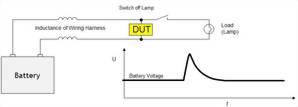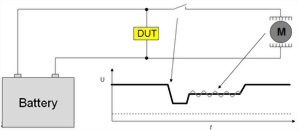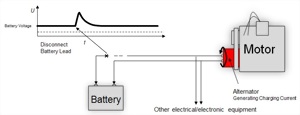Transient Immunity
n Transient Immunity
 Pulse 1 - A simulation
of transients due to supply disconnection from inductive loads; it applies to a
DUT if as used in the vehicle, it remains connected directly in parallel with
an inductive load
Pulse 1 - A simulation
of transients due to supply disconnection from inductive loads; it applies to a
DUT if as used in the vehicle, it remains connected directly in parallel with
an inductive load
 Pulse 2a - Simulates transients due to
sudden interruption of currents in a
device connected in parallel with the DUT due to the inductances of the wiring
harness
Pulse 2a - Simulates transients due to
sudden interruption of currents in a
device connected in parallel with the DUT due to the inductances of the wiring
harness
 Pulse 2b - Simulates transients from dc motors acting as generators after the ignition is switched off
Pulse 2b - Simulates transients from dc motors acting as generators after the ignition is switched off
 Pulse 3a/3b - Occurs as the result of
switching processes. The characteristics of this pulse are influenced by
distributed capacitance and inductance of the wiring harness
Pulse 3a/3b - Occurs as the result of
switching processes. The characteristics of this pulse are influenced by
distributed capacitance and inductance of the wiring harness
 Pulse 4 - The voltage reduction caused
by energizing the starter motor circuits of the internal combustion engines
Pulse 4 - The voltage reduction caused
by energizing the starter motor circuits of the internal combustion engines
 Pulse 4 Variants – Most manufacturer
variations of pulse four are generally much more complicated. For example Ford requires up to four
arbitrary generators with four outputs to be perfectly synchronized.
Pulse 4 Variants – Most manufacturer
variations of pulse four are generally much more complicated. For example Ford requires up to four
arbitrary generators with four outputs to be perfectly synchronized.
 Pulse 5 – Simulation of a load dump
transient occurring in the event of a discharged battery being disconnected
while the alternator is generating charging current with other loads remaining on the alternator circuit at this
moment
Pulse 5 – Simulation of a load dump
transient occurring in the event of a discharged battery being disconnected
while the alternator is generating charging current with other loads remaining on the alternator circuit at this
moment
 Magnetic Field Immunity – Simulates
magnetic fields generated by electric motors, daytime running lamps, etc. for
DUTs with magnetically sensitive devices.
Magnetic Field Immunity – Simulates
magnetic fields generated by electric motors, daytime running lamps, etc. for
DUTs with magnetically sensitive devices.
 Transformer Coupled Sine Waves –
Sinusoidal noise burst coupled on battery lines
Transformer Coupled Sine Waves –
Sinusoidal noise burst coupled on battery lines












